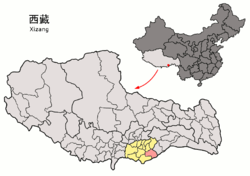Lhünzê County
Lhünzê County
隆子县 • ལྷུན་རྩེ་རྫོང་། Lhöntse Dzong | |
|---|---|
 Location of Lhünzê County (red) within Shannan City (yellow) and the Tibet Autonomous Region | |
| Coordinates: 28°49′56″N 93°16′25″E / 28.83222°N 93.27361°E | |
| Country | People's Republic of China |
| Autonomous region | Tibet |
| Prefecture-level city | Shannan |
| Seat | Lhünzê |
| Time zone | UTC+8 (China Standard) |

Lhünzê County, (Tibetan: ལྷུན་རྩེ་རྫོང་།, Wylie: lhun rtse rdzong, ZYPY: Lhünzê Zong; Chinese: 隆子县; pinyin: Lóngzǐ Xiàn, English: Lhöntse Dzong)[1] is a county of Shannan located in the south-east of the Tibet Autonomous Region. Part of Lhünzê County is claimed by India as part of Arunachal Pradesh, which is a disputed area between People's Republic of China and India.[2]
Geography
The Subansiri River, the largest tributary of the Brahmaputra, is formed in the county. A number of sub-tributaries such as Tsari Chu, Charme Chu, Nye Chu and Loro Chu, flow through the county, and join together in the adjoining Upper Subansiri district of Arunachal Pradesh in India.
Settlements
- Charme Dzong (Douyucun)
- Chayul Dzong (Jiayu)
- Migyutin (Zhari)
- Sangnag Chöling
- Yümai (Yume)
Climate
| Climate data for Lhünzê (1981−2010) | |||||||||||||
|---|---|---|---|---|---|---|---|---|---|---|---|---|---|
| Month | Jan | Feb | Mar | Apr | May | Jun | Jul | Aug | Sep | Oct | Nov | Dec | Year |
| Mean daily maximum °C (°F) | 7.6 (45.7) |
8.6 (47.5) |
11.6 (52.9) |
14.1 (57.4) |
17.7 (63.9) |
21.1 (70.0) |
20.5 (68.9) |
19.9 (67.8) |
18.9 (66.0) |
15.8 (60.4) |
11.6 (52.9) |
8.6 (47.5) |
14.7 (58.4) |
| Mean daily minimum °C (°F) | −12.8 (9.0) |
−10.5 (13.1) |
−6.4 (20.5) |
−2.4 (27.7) |
2.6 (36.7) |
7.5 (45.5) |
8.7 (47.7) |
8.2 (46.8) |
5.9 (42.6) |
−0.8 (30.6) |
−7.8 (18.0) |
−11.1 (12.0) |
−1.6 (29.2) |
| Average precipitation mm (inches) | 0.2 (0.01) |
0.6 (0.02) |
1.7 (0.07) |
9.3 (0.37) |
16.4 (0.65) |
38.0 (1.50) |
88.9 (3.50) |
78.3 (3.08) |
40.9 (1.61) |
9.8 (0.39) |
1.6 (0.06) |
0.8 (0.03) |
286.5 (11.29) |
| Source: National Meteorological Center of CMA[3] | |||||||||||||
Mining Controversy
In 2018, the Chinese government launched large-scale investments into mining precious metals like gold and silver from the region. This followed reports that rare earth minerals valued at over $60 billion had been found. Reports suggest that the gold rush has led to an unprecedented influx of people into the region. This is perceived as China's plan to claim the disputed border with India (Arunachal Pradesh) could turn the region into "another South China Sea".[4]
References
- ^ Bailey, Exploration on the Tsangpo (1914), p. 581.
- ^ India-China row: 8 disputed border areas that China claims as its own, The Economic Times, 12 July 2018.
- ^ 1981年-2010年(隆子)月平均气温和降水 (in Simplified Chinese). National Meteorological Center of CMA. Retrieved 25 November 2022.
- ^ Chen, Stephen (20 May 2018). "Beijing gold rush 'risks turning Himalayas into new South China Sea'". South China Morning Post. Retrieved 30 December 2019.
Bibliography
- Bailey, F. M. (1914). "Exploration on the Tsangpo or upper Brahmaputra". Scottish Geographical Magazine. 30 (11): 561–582. doi:10.1080/00369221408734154.
External links


